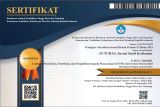The Essence of Mysticism in The Study of Tasawwuf
Authors (s)
(1) * Fitriyatul Hanifiyah
 (Universitas Islam Jember, Jember)
(Universitas Islam Jember, Jember) Indonesia
(*) Corresponding Author
AbstractSufism is another name for mysticism in Islam. the western orientalists it is known as Sufism, which is a special term for Islamic mysticism. Then the word Sufism does not exist in the mysticism of other religions. Sufism or mysticism in Islam is inherent in life and develops from zuhudan life, in the f amali Sufism, then philosophical Sufism. Sufism is the most important aspect of Islamic teachings, because the role of Sufism is the key to the perfection of the practice of Islamic teachings. In addition to the aspect of Sufism, in Islam there are other aspects, namely faith and sharia, or in other words what is meant by religion is consisting of Islam, faith and ihsan, where these three aspects are a unity. To know Islamic law, we have to refer to sharia / fiqih, to know the pillars of faith we have to refer to ushuludin / faith and to know the perfection of ihsan we enter into Sufism. The research method used in this research is literature review. For the results of this study that overall the science of Sufism can be grouped into two, namely tasawuf ilmi or nadhari, which is theoretical Sufism. The second part is Sufism amali or tathbiqi, which is applied Sufism, which is practical Sufism. It is not just a theory, but demands practice to achieve the goals of Sufism. As for what is meant by human relations and spirituality, namely humans think more deeply. Self-reflection will be awakened along with life's problems. Political, cultural and other problems will be resolved well with a cool head. A clean soul will radiate a clean implementation too. Meanwhile, the meaning of man's closeness to his God is based on some of the words of Allah SWT which are contained in the Al-Qur'an explaining that Allah is one with his servant (Al-Hulul / Wahdatul-Wujud).
|
Keywords
Mysticime, Sufism, Al-Hulul/Wahdatul-Wujud
Full Text: PDF
Refbacks
Copyright (c) 2021 Fitriyatul Hanifiyah
This journal is licensed under a
Creative Commons Attribution-ShareAlike 4.0 International License





.png)






